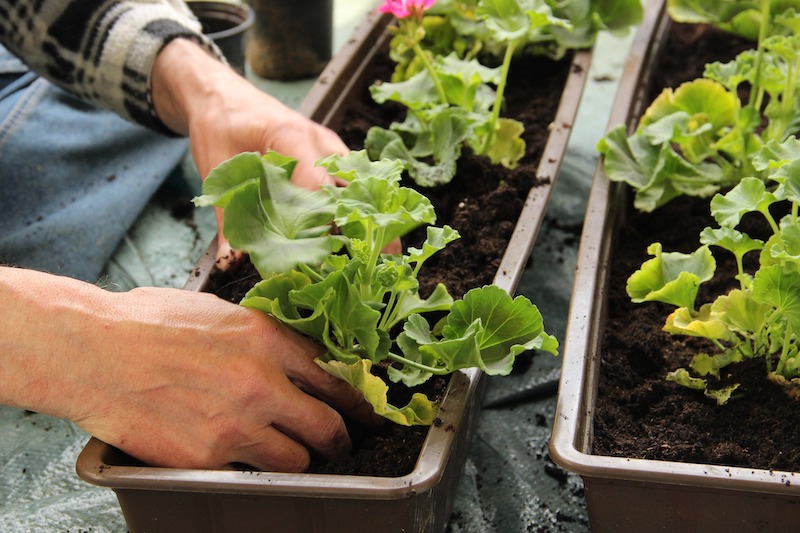Annuals and container gardening are a natural match. The shallow roots thrive in smaller containers such as hanging baskets or window boxes, which are often the final flourish for decorating a deck, patio, or front step with seasonal color. These short-lived plants flower heavily during a single season and can be changed at the gardener's discretion.

Planting Annuals Pots
Annuals come in cool and warm season types and can be planted just about anytime between early spring and late fall. Plant cool season types, such as pansies and early-growing vegetables, as soon as the soil can be easily dug in the spring. Warm-season annuals, such as tomatoes, peppers, and basil require nighttime temperatures higher than 50 degrees F. Use containers with good drainage at the bottom and large enough not to be top heavy as the plants grow to their full size. A soil-based potting mix with added perlite will keep containers and hanging baskets draining well and lightweight. Annuals typically can be planted closer together than perennials in containers and look best when planted in groups of three or more. A 10-inch hanging basket can easily hold three bedding plant annuals after they reach full size.

Best Soil For Annuals in Pots
The potting mix for annuals needs to be lightweight and moisture retentive. An all-purpose blend for containers containing a peat-free alternative, such as coconut coir, is ideal and more environmentally responsible than a peat-based mix. If the drainage holes are large, you can cover them with a piece of hardware cloth, window screening, or even a coffee filter to keep the soil from washing out during watering. Plant exceptionally large annuals in a plastic, cache pot that can be slipped inside a larger decorative pot. Use stacks of bricks or even other pots turned upside down to keep the inner liner at the correct height. Mulching with a thin layer of compost or worm castings will help to retain moisture longer in the pot and will add nutrients to the soil.
Caring For Annuals in Planters
Annuals grow wonderfully in containers and hanging baskets with only a few basic care requirements. Because containers and hanging baskets have a finite amount of room for annuals to grow, proper watering and fertilizing are crucial to keeping annuals blooming well into the fall. At the end of the season, the annuals can be discarded and replaced with a winter planting, or the pots can be moved into a garage or basement to overwinter.

Watering Annuals in Pots
Annuals perform best when their soil is kept consistently moist and not allowed to dry out fully. Only allow the top 1-2 inches of potting mix to dry between waterings. Water deeply until it runs from the bottom drainage holes, ensuring that all the soil has been saturated. Containers growing in cool, humid climates will need far less supplemental watering than those growing in hot and dry climates. As annuals mature, the roots will fill containers and need to be watered more often. During times of extended heat and drought, some containers may need to be watered daily.
Fertilizing Annuals in Pots
Regular fertilizing will produce a robust flower display or abundant harvest for most annuals. Watering of containers leaches nutrients from the soil that will need to be replaced. A diluted liquid formulation is ideal for containers and hanging baskets. The gardener can easily regulate the strength of the feedings. Liquid seaweed and fish emulsion are great organic choices, especially if the annuals will be consumed or used as a garnish in cooking. Dilute the fertilizer to half the recommended strength and apply it to containers every two weeks until the first frost in the fall.
Winter Care For Annuals in Pots
Annuals do not typically keep growing when the days start to shorten in late summer and more often than not, will die from the first frost of fall. Removing any diseased plant material from containers and garden beds is the best way to control future outbreaks. Throw the affected plants in municipal trash. Compost any other spent plant material or allow it to remain in place as shelter and food for local wildlife. Any pots made from delicate terracotta or ceramic should be emptied fully, cleaned well, and placed in a frost-free location to keep them safe from cracking or flaking. Any tender perennials grown as an annual may be cut back and overwintered in a frost-free garage or basement. Typically, pelargoniums and begonias respond well to this technique and can be successfully grown for many years.
Growing Annuals Indoors
Some annuals can be kept alive for a short time, although most annuals' life cycle depends on day length. Bring any annual indoors well before the nighttime temperatures fall below 50 degrees F and place them in the brightest window. Southern exposure is ideal. Water only when the top 2-3 inches of soil dries out.

 |
Author Robbin Small - Published 1-12-2023 |
